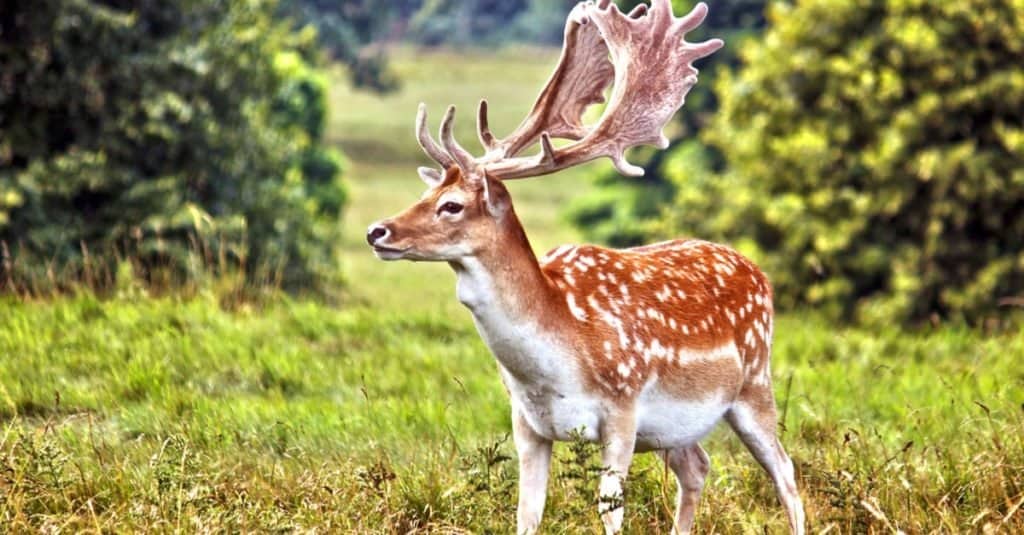The axis deer, Axis axis, is a regal-looking animal. It has shiny, golden-brown or golden-red fur across its body and legs as well as a broad white patch that runs down its throat. It is similar in size to an adult whitetail deer but exhibits permanent white speckles across its body that give it the appearance of an overgrown whitetail fawn.
Like the whitetail deer, the axis deer also exhibits sexual dimorphism, meaning that males and females are visually distinct. Males of the species develop large, sweeping antlers up to 30 inches in length and are generally larger than females. The males shed their antlers yearly on their day of birth, however, rather than with the seasons. Because they do not have a specific mating season, antler shedding can occur at any point during the year. Additionally, whereas whitetail bucks grow an increasing number of antler points with age, axis deer are almost universally six-pointed. Females have no antlers and have a smaller white patch down the neck.
Though they originated in a relatively small area of the world, the axis deer have managed to spread far and wide to inhabit the woodlands and grasslands that are similar to its native range. In some areas of the world, they are even considered invasive. In this article, we’ll take a look at where the axis deer originated and how it has come to inhabit such a wide range. We’ll talk about where they roam throughout the United States, how their presence is affecting native species and habitats, and how people are dealing with these foreign animals.

Male axis deer develop long, sweeping antlers up to 30 inches long! While whitetail deer grow an increasing number of antler points as they age, axis deer antlers rarely develop more than six points.
©GizmoPhoto/Shutterstock.com
Origin and Spread
Also known as the chital or spotted deer, the axis deer originated on the Indian subcontinent. Fairly large populations exist in the wild there throughout wide portions of India, Nepal, Bhutan, Bangladesh, and Sri Lanka, southward of the Himalayan Mountains. They inhabit a range of habitats, from grasslands to open forests.
Although they may have originated in the Indian subcontinent, these deer have managed to spread very far from their native range — even across the sea. For various reasons, humans have carried the axis deer to such faraway places as Australia, North America, and even the Hawai’ian Islands. Because they do not have many natural predators in these areas and are particularly good at competing for resources, axis deer are developing large populations there.
While their populations may be booming in other parts of the world, axis deer are becoming threatened in their native range. The expansion of human settlements is destroying the deer’s habitat and pushing them further into protected areas. Outside of these sanctuaries, the axis deer population is in decline.

Once limited to the Indian subcontinent, axis deer now reside in the United States by the thousands.
©iStock.com/Alberto Carrera
Where Are They in the U.S.?
Over the years, humans have imported these deer to the United States for many reasons. The first axis deer arrived on the continent in Texas in 1932, intended to serve as a game animal. For a while, efforts to restrict them to farms and closed hunting grounds were successful. As is the case with most imported plants and animals, however, they eventually escaped captivity. By 1988, researchers cataloged nearly 30 independent populations of free-roaming, reproducing herds of axis deer across the state. While a large portion of the state’s population remains contained today, there are more than 10,000 free-roaming axis deer throughout Texas.
The axis deer even made its way to California. In 2002, local biologists estimated that about 250 axis deer were roaming the Point Reyes National Seashore area. To prevent their spread, as well as that of the non-native fallow deer, the National Park Service began efforts to remove the deer from the wildlife area. Seven years later, in 2009, park biologists believed that the agency had successfully removed all of the axis deer from the area.
While the deer didn’t arrive on the North American continent until the 1900s, humans had introduced them to the Hawai’ian Islands decades prior. In 1867, traders brought several deer to the islands as a gift to King Kamehameha V. They were soon released on the island of Moloka’i. Decades later, in 1920, people transported populations to the island of Lāna’i, and by 1959, they had made it to Maui as well. Though an early population once existed on O’ahu around 1898, it has since died out completely. Today, their spread continues. In 2009, hunters illegally transported an additional population of axis deer to the island of Hawai’i. Their population on the island continues to grow by an average of 20 percent each year.
How Do Axis Deer Affect Native Species?
Though axis deer enjoy success in their new ranges across the world, it is largely at the expense of native flora and fauna. They fill the same ecological role as native whitetail deer, for example, forcing them to compete for the same resources. This is especially detrimental in the winter months when food is naturally scarce.
To make matters worse for the whitetails, axis deer do not have a limited mating season. While whitetails only mate for about 3 months out of the year, the non-native deer reproduce all year long. They also have no true natural predators in these areas to keep their numbers in check. This means that their populations grow much more rapidly than those of native deer, increasing the competition for food and space.
In addition to competing for resources, the non-native deer also increase the spread of a disease called paratuberculosis, or Johne’s disease, to other ruminants. While this includes the native whitetail deer, it also includes other wild ruminants, like elk and bison, as well as domesticated ones like cattle, sheep, and goats. Add all of these factors to the seasonal hunting of whitetails and it’s easy to see why their populations are declining in favor of the axis deer.
In areas where there are no natural predators at all, like the Hawai’ian Islands, axis deer wreak havoc on native plant populations. Many of these plant species are endemic to the island chain and grow nowhere else in the world. Throughout their evolutionary history, there were no grazing mammals on the island for the plants to contend with. With the arrival of the axis deer, who readily forage a variety of plants, many endemic plants have gone extinct.

Axis deer compete with native species for resources, especially in the winter when food is scarce.
©Rebecca C. Photography/Shutterstock.com
How Are People Managing the Axis Deer Populations?
Where there are too few predators to keep these deer in check or none at all, people are determined to create some. On Hawai’is Big Island, many residents collaborate with the Forestry and Wildlife Service, and each other, to carefully eliminate the deer populations that threaten their native wildlife. They follow in the footsteps of the other islands whose residents have struggled with the deer for decades.
In Texas, residents can hunt axis deer year-round. There are no legal bag limits, no possession limits, and no special conditions. The only thing they require of hunters is a non-game permit, which is separate from the state’s regular hunting license. They hope that removing legal hunting restrictions on non-native animals will help the native whitetails recover in the long run.

Texans are encouraged to hunt free-roaming axis deer to bring down their populations. The deer compete for resources with more than just wildlife — herds will also forage in cropland and pastures.
©Trong Nguyen/Shutterstock.com
Are There Other Invasive Deer Species in the U.S.?

The fallow deer is another type of invasive deer species that somehow found its way to the United States.
©Neil Clarke/Shutterstock.com
Yes, there are other invasive deer species in the U.S. besides axis deer. One such is the Sitka deer, which is native to Korea, Japan, Eastern China, and southeastern Siberia. Sitka deer were brought to the Chesapeake Bay area of the U.S. in 1916, with 4-5 deer being released in Dorchester County, Maryland on James Island. Today, Sitka deer have established populations in Maryland, Oklahoma, Virginia, Texas, and Wisconsin.
Fallow deer have a long history dating back to the Pleistocene period. They were present at different times in Europe and the Middle East, and today can be found in places like the U.K., Falkland Islands, Madagascar, and even South Africa. In the U.S., fallow deer are only found in a few distinct areas: the Point Reyes National Seashore in California; a barrier island off the coast of Georgia; Land Between the Lakes in Kentucky; and on a few preserves and military bases in Texas.
Similar to elk, Sambar deer are one more invasive deer species that find their roots in Asia. This species of deer is sometimes owned by wealthy individuals, such as a herd near Hearst Castle in California. Another herd was placed on the privately owned St. Vincent Island, along with white-tailed deer and feral hogs. The island was later sold, and other people put other animals on the island including African antelopes and zebras!
The photo featured at the top of this post is © Ondrej Prosicky/Shutterstock.com
Thank you for reading! Have some feedback for us? Contact the AZ Animals editorial team.







